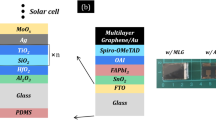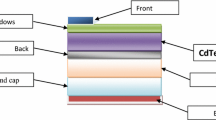Abstract
Performances of solar cells with different window materials and structures have been analysed and compared. Four different materials with varied thickness have been used for comparison. An efficient thin textured window layer design with double layer anti reflection coating for III–V solar cell is then proposed. The optimum window is obtained with 18 nm InAlP material and further optimized with four sided textured surface coated with 125 nm double antireflective layer of \(\hbox {Al}_{2}\hbox {O}_{3}\)–\(\hbox {TiO}_{2}\). Our design shows minimum reflection and absorption loss in the wavelength range of 200–650 nm and better transmission for rest of the higher wavelength when illuminated with AM1.5G spectrum. Performance variation with different doping concentration on this layer is also investigated. At about \(1\times 10^{17}\) \(\hbox {cm}^{-3}\) carrier concentration, EQE of the cell is found to be well above 95 %. The model has been validated with experimental data available from various recent literatures.



















Similar content being viewed by others
References
Dzhafarov, T.: Silicon solar cells with nanoporous silicon layer. In: Professor Morales-Acevedo, A. (ed.) Solar Cells-Research and Application Perspectives, p. 42. InTech Open Science, Croatia, Europe (2013)
Gupta, S., Srivastaya, M., Gupta, A.: Mathematical formulation comparative analysis of losses in solar cells. http://www.tutorialspoint.com/white-papers. Accessed 12 May 2012
Garnett, E., Yang, P.: Light trapping in silicon nanowire solar cells. Nano Lett. 10, 1082 (2010)
Green, M.A., Emery, K., Hishikawa, Y., Warta, W., Dunlop, E.D.: Solar cell efficiency tables (version 41). Prog. Photovolt. 21, 1 (2013)
Aiken, D.J.: High performance antireflection coatings for broadband multi-junction solar cells. Sol. Energy Mater. Sol. Cells 64, 393 (2000)
Hans Joachim Moller: Semiconductor for Solar cells. Artech House, Boston (1993)
SOPRA.: ”N & K Database”. http://www.sopra-sa.com. Accessed 15 June 2010
Green, M.: High Efficiency Silicon Solar Cells. Trans Tech Publications, Dürnten (1987)
Vurgaftman, I., Meyer, J.R., Ram-Mohan, L.R.: Band parameters for III–V semiconductors and their alloys. J. Appl. Phys. 89(11), 5815–5875 (2001)
SILVACO Data Systems Inc.: Silvaco ATLAS User’s Manual (2009)
Olson, J.M., Friedman, D.J., Kurtz, S.: Handbook of Photovoltaic Science and Engineering, uque, A., Hegedus, S. (eds.), p. 387. Wiley, Chichester (2003)
King, R.R., et al.: High-efficiency space and terrestrial multijunction solar cells through bandgap control in cell structures. In: Proceedings of the 29th IEEE Photovoltaic Specialists Conference (New Orleans), Piscataway, p. 776. IEEE (2002)
Hashizume, T.: Surface Fermi-level position and gap state distribution of InGaP surface grown by metalorganic vapor-phase epitaxy Appl. Phys. Lett. 81, 2382 (2002)
Karam, N.H., et al.: Recent developments in high-efficiency Ga0.5In0.5P/GaAs/Ge dual- and triple-junction solar cells: steps to next-generation PV cells. Sol. Energy Mater. Sol. Cells 66, 453 (2001)
Law, D.C., Fetzer, C.M., King, R.R., Colter, P.C., Yoon, H., Isshiki, T.D., Edmondson, K,M., Haddad, M., Karam, N.H.: Multijunction solar cells with subcell materials highly lattice-mismatched to germanium. In: Proceedings of the 31st IEEE Photovoltaic Specialists Conference (Orlando), Piscataway, p. 575. IEEE (2005)
Jackson, J.D.: Classical Electrodynamics, 2nd edn. John Wiley, New York (1975). ISBN: 047143132X
Jahanshah, F., Sopian, K., Zaidi, S.H., Othman, M.Y., Amin, N., Asim, N.: Modeling the effect of P-N junction depth on the output of planer and rectangular textured solar cells. Am. J. Appl. Sci. 6(4), 667–671 (2009)
Zaidi, S.H., Marquadt, R., Minhas, B., Tringe, J.W.: Deeply etched grating structures for enhanced absorption in thin C-Si solar cells. In: Proceeding of the 20th Conference on Photovoltaic Specialists, May 19–24, pp. 1290–1293. IEEE Computer Society, Washington DC (2002)
Nelson, J.: The Physics of Solar Cells, 1st edn, p. 450. Imperial College Press, London (2003). ISBN 13: 9781860943492
Neamen, D.A.: Semiconductor Physics and Devices: Basic Principles, 1st edn, p. 746. IRWIN, Boston (1992). ISBN 10 025608405X
Singh, K.J., Sarkar, S.K.: Highly efficient ARC less InGaP/GaAs DJ solar cell numerical modeling usingoptimized InAlGaP BSF layers. Opt. Quantum Electron. 43, 1–21 (2012)
Sze, S.M.: Physics of Semiconductor Devices, 2nd edn, pp. 811–812. Wiley, New York (1981)
Aspnes, D.E., Kelso, S.M., Logan, R.A., Bhat, R.: Optical properties of AlxGa1-xAs alloy of same band-gap. J. Appl. Phys. 60(2), 754–767 (1986)
Yoshikawa, A., Kasai’, H.: Optimum design for window layer thickness of GaAIAs-GaAs heteroface solar cell regarding the effect of reflection loss. J. Appl. Phys. 52(6), 4345–4347 (1981)
Pla, J., Barrera, M., Rubinelli, F.: The influence of the InGaP window layer on the optical and electrical performance of GaAs solar cells. Semicond. Sci. Technol. 22, 1122–1130 (2007)
Wojtczuk, S.J., Vernon, S.M., Sanfacon, M.M.: Comparison of windows for P-on-N InGaP solar cells. In: Proceedings of the Photovoltaic Specialists Conference, 1993, Conference Record of the Twenty Third IEEE (1993)
Bouhafs, D., Moussi, A., Chikouche, A., Ruiz, J.M.: Design and simulation of antireflection coating systems for optoelectronic devices: application to silicon solar cells. Solar Energy Mater. Solar Cells 52, 79–93 (1998)
Richards, B.S.: Single-material TiO2 double-layer antireflection coatings. Solar Energy Mater. Solar Cells 79, 369–390 (2003)
Sttehlke, S., Bastide, S., Guillet, J., Levy-Clement, C.: Design of porous silicon antireflection coatings for silicon solar cells. Mat. Sci. Eng. B 69, 81–86 (2000)
Wright, D.N., Marstein, E.S., Holt, A.: Double layer anti-reflective coatings for silicon solar cells. In: Proceedings of the 31st IEEE Photovoltaic Specialists Conference, Orlando, FL, pp. 1237–1240.IEEE (2005)
Redfield, D.: Method for evaluation of antireflection coatings. Solar Cells 3, 27–33 (1981)
Author information
Authors and Affiliations
Corresponding author
Rights and permissions
About this article
Cite this article
Singh, K.J., Singh, N.B. & Sarkar, S.K. Textured window with DLAR coating design for an effective minimization of electrical and optical losses in an efficient III–V solar cell. J Comput Electron 14, 288–299 (2015). https://doi.org/10.1007/s10825-014-0652-2
Published:
Issue Date:
DOI: https://doi.org/10.1007/s10825-014-0652-2




